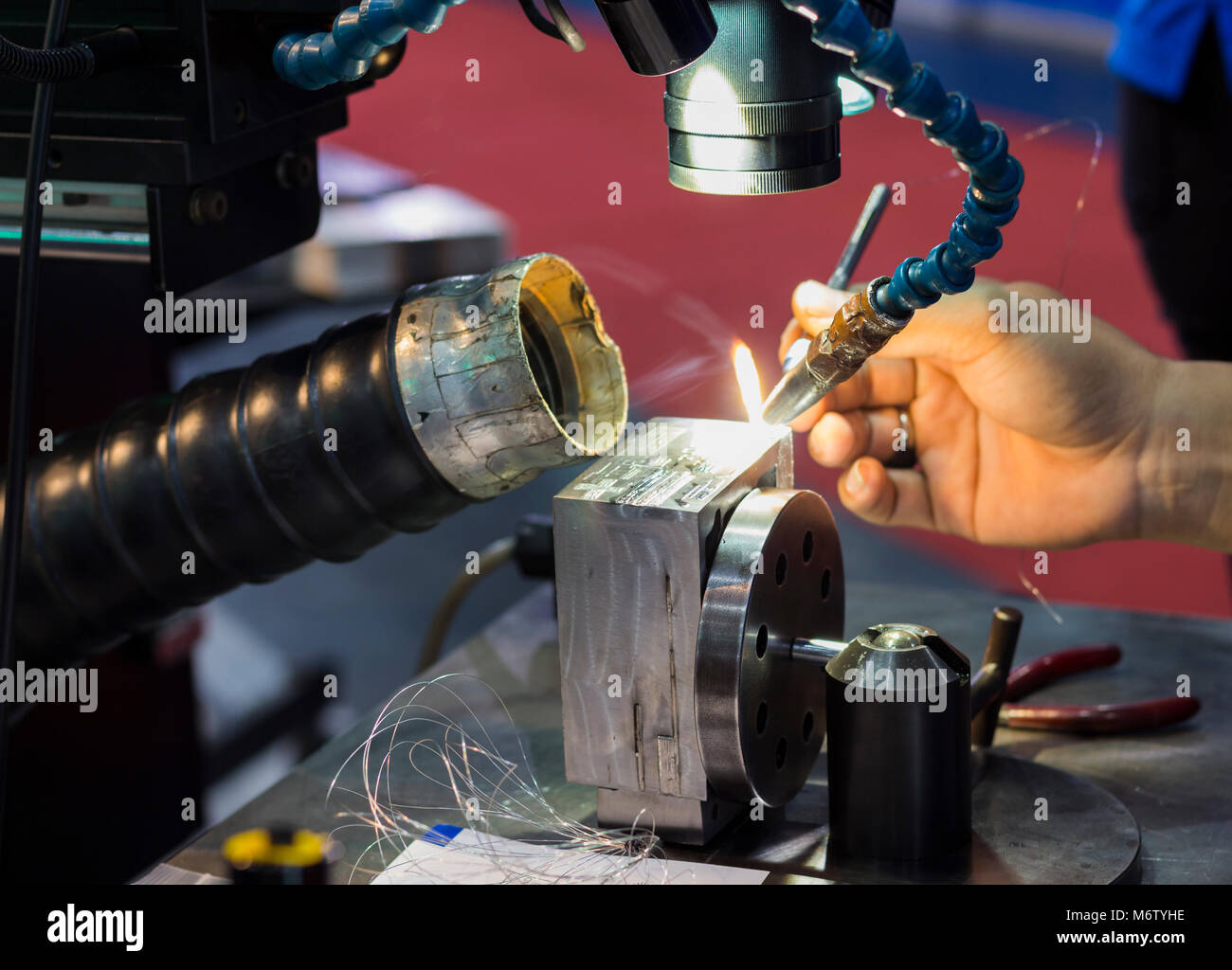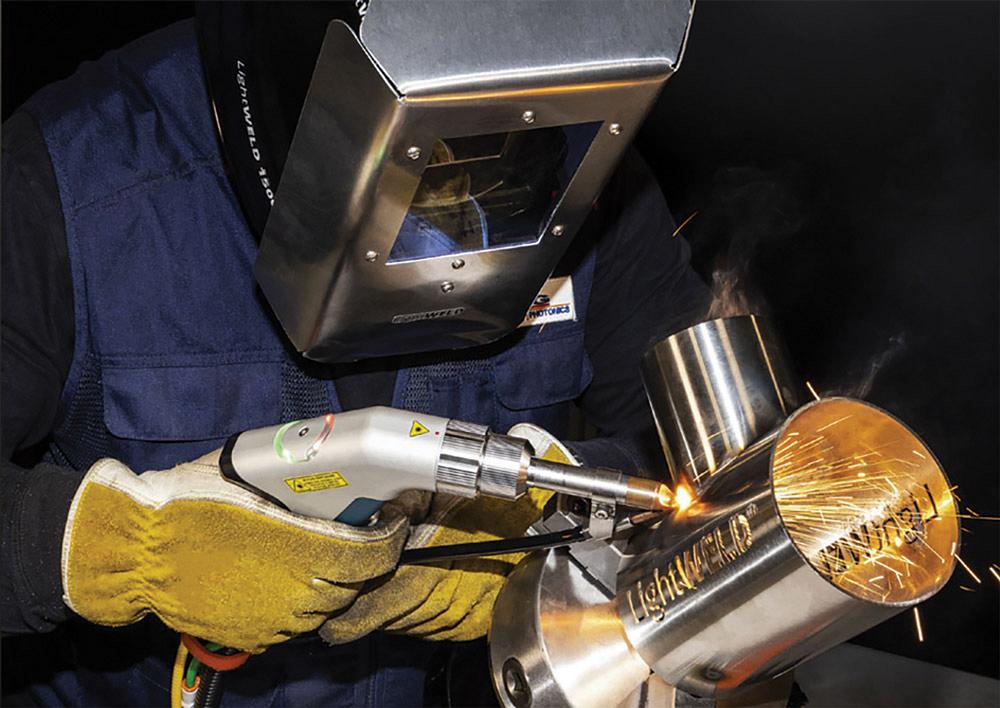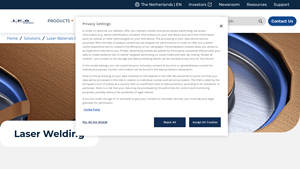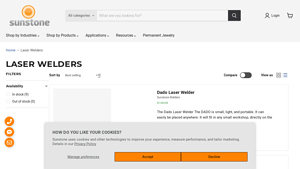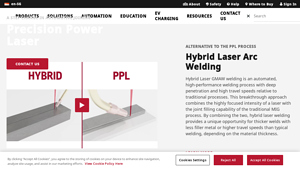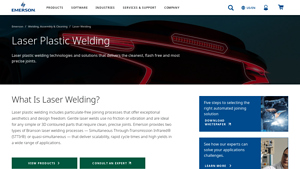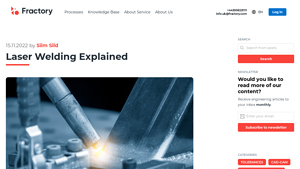Precision Laser Welding Guide: Type, Cost, Top List…
Introduction: Navigating the Global Market for precision laser welding
In today’s fast-paced industrial landscape, sourcing precision laser welding solutions can pose significant challenges for B2B buyers. As the demand for high-quality, durable, and efficient joining techniques grows across diverse sectors—including aerospace, automotive, and medical devices—companies must navigate an increasingly complex global market. This guide is designed to empower international buyers, particularly those from Africa, South America, the Middle East, and Europe, by providing essential insights into the various types of precision laser welding technologies, their applications, and critical factors to consider when selecting a supplier.
Throughout this comprehensive guide, readers will discover the intricacies of different welding techniques, including Nd:YAG, electron beam, and micro-welding. Each method offers unique advantages tailored to specific industry needs, ensuring that businesses can achieve optimal results. Furthermore, we will delve into effective supplier vetting processes, helping buyers assess qualifications, certifications, and performance histories to ensure they partner with reputable manufacturers.
Additionally, this guide addresses cost considerations and best practices for negotiating contracts, enabling informed purchasing decisions that align with budgetary constraints while maintaining quality standards. By equipping B2B buyers with actionable insights, this resource aims to streamline the sourcing process and foster successful collaborations in the evolving world of precision laser welding.
Understanding precision laser welding Types and Variations
| Type Name | Key Distinguishing Features | Primary B2B Applications | Brief Pros & Cons for Buyers |
|---|---|---|---|
| Nd:YAG Laser Welding | Low heat input, minimal distortion, suitable for precision tasks | Aerospace, Medical Devices | Pros: High precision, low distortion; Cons: Limited penetration depth. |
| Fiber Laser Welding | High-speed operation, excellent beam quality, versatile | Automotive, Electronics | Pros: Fast processing, energy-efficient; Cons: Initial equipment cost can be high. |
| Laser Hybrid Welding | Combines laser and arc welding for greater penetration | Heavy Industries, Shipbuilding | Pros: Deep welds, effective for thick materials; Cons: Complexity in setup and control. |
| Ultrafast Laser Welding | Extremely short pulse durations to minimize heat-affected zones | Microelectronics, Precision Parts | Pros: Minimal thermal impact, high precision; Cons: Requires specialized equipment. |
| Laser Cladding | Adds material to a surface for wear resistance and repair | Aerospace, Tool Manufacturing | Pros: Enhances surface properties; Cons: Requires careful control to avoid defects. |
What Are the Key Characteristics of Nd:YAG Laser Welding?
Nd:YAG (Neodymium-doped Yttrium Aluminum Garnet) laser welding is characterized by its low heat input, which minimizes distortion and is ideal for joining thin materials. This method is particularly advantageous in industries like aerospace and medical devices, where precision is paramount. Buyers should consider the specific material types and thicknesses they need to weld, as Nd:YAG is less effective for thicker components due to limited penetration depth.
How Does Fiber Laser Welding Benefit B2B Applications?
Fiber laser welding utilizes a high-quality beam that allows for fast and efficient welding processes. Its versatility makes it suitable for a range of applications, particularly in the automotive and electronics sectors. The primary consideration for buyers is the initial investment in fiber laser technology, which can be higher than traditional methods. However, the long-term savings in operational efficiency often justify this cost.
What Advantages Does Laser Hybrid Welding Offer?
Laser hybrid welding combines the benefits of laser and arc welding to achieve deeper penetration, making it suitable for heavy industries and shipbuilding. This method is particularly effective for thicker materials, providing strong, durable welds. Buyers should be aware of the complexity involved in setting up hybrid systems, as they require more sophisticated controls and expertise.
Why Choose Ultrafast Laser Welding for Precision Parts?
Ultrafast laser welding employs extremely short pulse durations to significantly reduce the heat-affected zone, making it ideal for microelectronics and precision parts. The minimal thermal impact allows for high precision in delicate components. Buyers must consider the need for specialized equipment and training, as this advanced technology may not be readily available in standard welding setups.
How Does Laser Cladding Enhance Material Properties?
Laser cladding is a process that adds material to a surface, enhancing wear resistance and enabling repairs. This method is widely used in aerospace and tool manufacturing to improve surface properties without compromising the integrity of the base material. Buyers should evaluate the specific requirements for surface enhancement and the control measures necessary to avoid defects during the cladding process.
Key Industrial Applications of precision laser welding
| Industry/Sector | Specific Application of Precision Laser Welding | Value/Benefit for the Business | Key Sourcing Considerations for this Application |
|---|---|---|---|
| Aerospace | Joining complex components in aircraft structures | Enhanced strength-to-weight ratio, reduced overall weight | Compliance with industry regulations (e.g., FAA), material certifications |
| Medical Devices | Fabrication of intricate medical implants | High precision and reliability, critical for patient safety | ISO certifications, biocompatibility of materials, quality assurance |
| Automotive | Welding battery packs for electric vehicles | Improved energy efficiency and performance, critical for EV market | Material compatibility, lightweight designs, scalability of production |
| Energy | Assembly of solar panel components | Increased energy output and durability, essential for sustainability | Supply chain reliability, adherence to environmental regulations |
| National Defense | Manufacturing of precision weapons components | High durability and performance under extreme conditions | ITAR compliance, specialized materials, rigorous testing standards |
How is Precision Laser Welding Transforming the Aerospace Industry?
In the aerospace sector, precision laser welding is utilized to join complex components in aircraft structures, such as fuselage sections and wing assemblies. This method enhances the strength-to-weight ratio, which is critical for fuel efficiency and overall performance. International buyers should ensure that their suppliers comply with stringent industry regulations, such as those set forth by the FAA, and that materials used are certified to withstand the high-stress environments typical in aerospace applications.
What Role Does Precision Laser Welding Play in Medical Device Manufacturing?
In the medical device industry, precision laser welding is pivotal for fabricating intricate medical implants, including stents and surgical tools. The process offers high precision and reliability, which are essential for ensuring patient safety. Buyers from regions with strict health regulations, such as Europe and the Middle East, must prioritize suppliers that hold ISO certifications and can guarantee the biocompatibility of materials used in medical applications. Quality assurance protocols are also critical to meet regulatory standards.
How is Precision Laser Welding Advancing Automotive Battery Production?
Precision laser welding is increasingly employed in the automotive industry, particularly for welding battery packs in electric vehicles (EVs). This application is vital as it contributes to improved energy efficiency and performance, which are key factors in the competitive EV market. Buyers must consider material compatibility and the ability of suppliers to deliver lightweight designs that meet stringent automotive standards. Additionally, scalability of production processes is crucial for meeting growing demand.
In What Ways is Precision Laser Welding Enhancing Energy Solutions?
In the energy sector, precision laser welding is used to assemble solar panel components, enhancing both energy output and durability. This application is particularly significant in regions focused on sustainability and renewable energy initiatives. International buyers should ensure their sourcing partners have reliable supply chains and adhere to environmental regulations that govern the production of solar technologies. The ability to deliver consistent quality and performance is essential for long-term partnerships.
How is Precision Laser Welding Impacting National Defense Manufacturing?
Precision laser welding is essential in the national defense sector for manufacturing precision weapons components. The technology allows for the creation of highly durable and performance-oriented parts that can withstand extreme conditions. Buyers in this sector, particularly in regions like the Middle East, must ensure that their suppliers comply with ITAR regulations and can provide specialized materials that meet rigorous testing standards. Establishing partnerships with reliable manufacturers is crucial for maintaining operational readiness.
3 Common User Pain Points for ‘precision laser welding’ & Their Solutions
Scenario 1: The Challenge of Material Compatibility in Precision Laser Welding
The Problem: One of the most significant challenges B2B buyers face when utilizing precision laser welding is ensuring material compatibility. Many industries, particularly aerospace and medical devices, require the joining of dissimilar materials. This compatibility issue can lead to compromised weld quality, increased production costs, and project delays. Buyers often find themselves unsure about which materials can be effectively welded together without causing defects such as cracking, porosity, or insufficient bonding strength.
The Solution: To navigate material compatibility challenges, it is crucial to engage with a welding service provider that has extensive experience in laser welding of diverse materials. Begin by conducting thorough research on your specific materials and their properties. Utilize the expertise of a welding consultant who can guide you in selecting appropriate filler materials and process parameters. For instance, employing techniques like pulsed Nd:YAG laser welding can reduce heat input and minimize thermal distortion, making it suitable for sensitive materials. Additionally, consider conducting preliminary tests or trials with your selected materials to validate compatibility before full-scale production. This proactive approach can help mitigate risks and ensure successful outcomes.
Scenario 2: Inconsistent Weld Quality Across High-Volume Production
The Problem: B2B buyers often encounter issues with inconsistent weld quality during high-volume production runs. Variations in weld strength, appearance, or dimensional accuracy can lead to costly rework and potential product failures, especially in industries like automotive and defense where precision is paramount. This inconsistency can stem from several factors, including equipment calibration, operator skill levels, and variations in material properties.
The Solution: To address quality inconsistencies, implement a robust quality control system that includes regular monitoring and calibration of laser welding equipment. Establish standard operating procedures (SOPs) for operators, ensuring they are trained and certified to handle specific welding tasks. Utilize automated laser welding systems that provide real-time feedback on weld quality, allowing for immediate adjustments. Additionally, incorporate advanced inspection techniques such as laser triangulation or thermography to assess weld integrity post-production. By investing in both technology and training, you can achieve consistent weld quality that meets industry standards and reduces the risk of defects.
Scenario 3: The Complexity of Regulatory Compliance in Precision Laser Welding
The Problem: Navigating the complex landscape of regulatory compliance is a common pain point for B2B buyers in industries such as medical devices and aerospace, where strict standards govern manufacturing processes. Buyers often struggle to ensure that their precision laser welding processes meet relevant regulations, which can lead to delays in product launch or costly fines. The intricacies of certifications like ISO and ITAR can be overwhelming, especially for companies new to these requirements.
The Solution: To simplify compliance, engage a welding partner who is not only experienced in precision laser welding but also well-versed in the regulatory landscape relevant to your industry. Before starting any project, conduct a comprehensive compliance assessment to identify applicable regulations. Collaborate with your welding provider to ensure that all processes, materials, and documentation align with regulatory requirements. Additionally, consider leveraging certifications such as ISO 9001 to enhance your credibility and commitment to quality. Regular training sessions for your team on compliance best practices can also be beneficial. By integrating compliance into your project planning from the outset, you can minimize risks and streamline the certification process, ultimately supporting a smoother path to market for your products.
Strategic Material Selection Guide for precision laser welding
What Are the Key Properties of Common Materials Used in Precision Laser Welding?
When selecting materials for precision laser welding, understanding the specific properties of each material is crucial for ensuring optimal performance. Here, we analyze four common materials: stainless steel, aluminum, titanium, and copper. Each material has unique properties that can significantly influence the outcome of a welding project.
How Does Stainless Steel Perform in Precision Laser Welding?
Stainless steel is renowned for its excellent corrosion resistance and mechanical strength. It typically has a temperature rating of up to 800°C and is capable of withstanding high pressures, making it suitable for various applications, including automotive and aerospace components.
Pros: Its durability and resistance to oxidation make stainless steel ideal for challenging environments. Additionally, it is widely available and can be cost-effective in bulk.
Cons: The welding process can be complex due to the risk of warping and distortion. Furthermore, the cost of high-grade stainless steel can be significant, depending on the alloy used.
Impact on Application: Stainless steel is compatible with a wide range of media, including corrosive substances, which is essential for industries like food processing and pharmaceuticals.
Considerations for International Buyers: Compliance with standards such as ASTM A240 or EN 10088 is critical. Buyers from regions like Europe may prefer specific grades, such as 316L, for their enhanced corrosion resistance.
What Advantages Does Aluminum Offer for Precision Laser Welding?
Aluminum is lightweight and exhibits excellent thermal conductivity, making it a popular choice in the automotive and aerospace sectors. It can withstand temperatures up to 600°C, and its low density contributes to reduced weight in applications.
Pros: The primary advantage of aluminum is its weight-to-strength ratio, which enhances fuel efficiency in vehicles. It is also relatively easy to weld, especially with laser technology.
Cons: Aluminum is more susceptible to oxidation, which can complicate the welding process. Additionally, the cost can be higher compared to other metals, particularly for high-purity grades.
Impact on Application: Aluminum is compatible with various media, including water and air, but care must be taken with corrosive environments.
Considerations for International Buyers: Compliance with standards like ASTM B221 is essential. Buyers should also be aware of regional preferences for specific aluminum alloys, such as 6061 or 7075, depending on their application needs.
Why Is Titanium a Preferred Material for Precision Laser Welding?
Titanium is known for its exceptional strength-to-weight ratio and corrosion resistance, making it ideal for high-performance applications in aerospace and medical devices. It can withstand temperatures exceeding 1,600°C, making it suitable for high-heat environments.
Pros: Its biocompatibility and resistance to corrosion make titanium an excellent choice for medical implants and aerospace components.
Cons: The cost of titanium is significantly higher than that of other metals, and the welding process can be complex, requiring specialized techniques and equipment.
Impact on Application: Titanium is highly compatible with various media, including saline solutions, which is crucial for the medical industry.
Considerations for International Buyers: Compliance with ASTM F136 for medical-grade titanium or AMS 4911 for aerospace applications is vital. Buyers in Europe may also need to adhere to specific EU regulations regarding material safety.
How Does Copper Perform in Precision Laser Welding?
Copper is well-regarded for its excellent electrical and thermal conductivity, making it a favored material in electrical applications and heat exchangers. It can withstand temperatures up to 1,085°C.
Pros: The primary advantage of copper is its superior conductivity, which is essential for electrical components. Additionally, it has good corrosion resistance in certain environments.
Cons: Copper can be challenging to weld due to its high thermal conductivity, which can lead to heat dissipation issues. It is also more expensive than some alternatives.
Impact on Application: Copper is compatible with various media, particularly in electrical and thermal applications.
Considerations for International Buyers: Compliance with standards such as ASTM B224 is critical. Buyers should also consider local preferences for specific copper grades, depending on their application.
Summary Table of Material Selection for Precision Laser Welding
| Material | Typical Use Case for precision laser welding | Key Advantage | Key Disadvantage/Limitation | Relative Cost (Low/Med/High) |
|---|---|---|---|---|
| Stainless Steel | Automotive, aerospace components | Excellent corrosion resistance | Risk of warping during welding | Medium |
| Aluminum | Aerospace, automotive parts | Lightweight and good thermal conductivity | Susceptible to oxidation | Medium |
| Titanium | Medical implants, aerospace components | Exceptional strength-to-weight ratio | High cost and complex welding process | High |
| Copper | Electrical components, heat exchangers | Superior electrical and thermal conductivity | Difficult to weld due to heat dissipation | High |
This strategic material selection guide provides valuable insights for international B2B buyers, enabling informed decisions that align with their specific application needs and compliance requirements.
In-depth Look: Manufacturing Processes and Quality Assurance for precision laser welding
What Are the Key Stages in the Manufacturing Process of Precision Laser Welding?
The manufacturing process for precision laser welding is multi-faceted, encompassing several critical stages that ensure high-quality outcomes. Understanding these stages is essential for B2B buyers looking to collaborate with suppliers capable of delivering reliable and precise welding solutions.
1. Material Preparation: How is Material Readied for Laser Welding?
The first step in precision laser welding involves meticulous material preparation. This phase includes cleaning and conditioning the materials to be welded, ensuring that surfaces are free from contaminants such as oils, dust, or oxides. Common techniques for cleaning include chemical treatments and mechanical polishing. Properly prepared materials enhance the quality of the weld and reduce the likelihood of defects.
In addition to cleaning, the selection of materials plays a vital role. Different metals and alloys respond differently to laser welding, so understanding the material properties is crucial. For instance, materials like stainless steel, aluminum, and titanium are popular in various industries, including aerospace and medical devices, due to their favorable welding characteristics.
2. Forming: What Techniques are Used to Shape Components?
Following material preparation, the next phase is forming the components. This process may involve cutting, bending, or shaping the materials to achieve the desired geometry. Techniques such as laser cutting or machining are often employed to ensure precision.
In precision laser welding, the fit-up of components is particularly important. Ensuring that parts align correctly before welding minimizes gaps and inconsistencies, which can lead to weak welds. Advanced fixtures and jigs are often used to maintain the integrity of the assembly during the welding process.
3. Assembly: How are Components Joined Using Laser Technology?
The assembly phase is where the actual laser welding occurs. High-powered lasers, such as Nd:YAG or fiber lasers, are commonly used due to their precision and ability to penetrate various materials. The laser generates a concentrated heat source that melts the materials at the joint, allowing them to fuse together.
Automation plays a significant role in this stage, with many manufacturers using robotic systems to enhance accuracy and repeatability. The integration of automated filler wire systems can also be beneficial, especially for challenging materials that require additional support to achieve a strong bond.
4. Finishing: What Post-Weld Processes Ensure Quality?
After welding, the components undergo finishing processes to remove any imperfections and ensure compliance with specifications. Techniques such as grinding, polishing, or surface treatment may be applied to achieve the desired finish. This stage may also include inspections to verify the integrity of the welds.
How is Quality Assurance Implemented in Precision Laser Welding?
Quality assurance (QA) is critical in precision laser welding, ensuring that the final products meet international standards and customer specifications. B2B buyers should be familiar with the QA processes that suppliers implement.
1. What International Standards Are Relevant to Laser Welding Quality?
Many industries adhere to international quality standards to ensure consistency and reliability. ISO 9001:2015 is one of the most widely recognized standards for quality management systems. It emphasizes a process-oriented approach and continuous improvement, which is crucial in the laser welding industry.
In addition to ISO certifications, industry-specific standards may also apply. For example, medical device manufacturers must comply with ISO 13485, while aerospace components might need to meet AS9100 standards. Buyers should verify that their suppliers possess the necessary certifications relevant to their industry.
2. What Are the Key Quality Control Checkpoints?
Quality control (QC) checkpoints are integral to maintaining high standards throughout the manufacturing process. Common QC checkpoints include:
- Incoming Quality Control (IQC): This involves inspecting raw materials upon arrival to ensure they meet specified requirements.
- In-Process Quality Control (IPQC): During the manufacturing process, samples are frequently inspected to catch any deviations early.
- Final Quality Control (FQC): After production, finished products undergo thorough testing and inspection before delivery.
These checkpoints help identify and mitigate potential issues, ensuring that only products meeting quality standards reach the customer.
3. What Common Testing Methods Are Employed?
Various testing methods are utilized to verify the quality of laser welds. Common techniques include:
- Visual Inspection: A straightforward method for identifying surface defects.
- Ultrasonic Testing: Used to detect internal flaws by sending high-frequency sound waves through the material.
- X-Ray Inspection: Provides a detailed view of the weld integrity and can identify voids or inclusions.
- Tensile Testing: Measures the strength of the weld by applying force until failure.
Each method serves a specific purpose, contributing to a comprehensive quality assurance strategy.
4. How Can B2B Buyers Verify Supplier Quality Control?
B2B buyers should take proactive steps to verify the quality control measures of potential suppliers. Here are some actionable insights:
- Conduct Audits: Regular audits of suppliers’ facilities can provide firsthand insight into their manufacturing processes and quality management systems.
- Request Quality Reports: Suppliers should be willing to provide documentation detailing their quality control measures, including inspection results and certification status.
- Engage Third-Party Inspectors: Independent inspections can offer an unbiased evaluation of a supplier’s capabilities and adherence to standards.
5. What Are the Quality Control Nuances for International Buyers?
For international B2B buyers, particularly those from regions such as Africa, South America, the Middle East, and Europe, understanding local regulations and compliance requirements is essential. Different regions may have specific certifications, such as CE marking in Europe or API standards in the oil and gas sector.
Additionally, cultural differences in business practices may affect communication and expectations regarding quality. Establishing clear agreements and understanding the legal framework of both parties can mitigate potential issues.
Conclusion
Precision laser welding is a sophisticated manufacturing process that requires careful attention to detail throughout all stages—from material preparation to finishing. Quality assurance is paramount, with international standards and rigorous testing methods ensuring that the final products meet the highest quality expectations. By understanding these processes and QC measures, B2B buyers can make informed decisions when selecting suppliers, ultimately enhancing their supply chain and product reliability.
Practical Sourcing Guide: A Step-by-Step Checklist for ‘precision laser welding’
Introduction
This practical sourcing guide provides B2B buyers with a structured checklist for procuring precision laser welding services. Precision laser welding is critical for industries such as aerospace, automotive, and medical devices, where high-quality joins are paramount. Following this checklist ensures that you select the right partner to meet your technical requirements and business objectives.
Step 1: Define Your Technical Specifications
Clearly outline your project requirements before initiating the procurement process. This includes the types of materials to be welded, the thickness of the components, and the desired joint characteristics.
– Considerations: Specify if you need high-precision joins, heat-affected zone limitations, or particular tolerances. Providing detailed specifications helps potential suppliers assess their capability to meet your needs.
Step 2: Research Potential Suppliers
Conduct thorough research to identify suppliers with expertise in precision laser welding. Look for companies with a strong reputation and experience in your specific industry.
– Key Sources: Utilize industry directories, trade shows, and professional networks. Online reviews and testimonials can provide insights into supplier reliability and service quality.
Step 3: Evaluate Supplier Certifications
Verify that the suppliers hold relevant industry certifications such as ISO 9001:2015 and ITAR registrations. Certifications indicate adherence to quality standards and regulatory compliance, which are vital for high-stakes projects.
– Importance: Certifications ensure that the supplier has met rigorous quality management standards, which can translate to superior welding outcomes.
Step 4: Request Technical Proposals
Engage with shortlisted suppliers by requesting detailed technical proposals. These should outline their welding processes, technologies used, and any innovative methods they employ.
– What to Look For: Assess their capability to handle your specific materials and welding requirements. Compare the proposed methodologies to ensure they align with your project goals.
Step 5: Inspect Quality Assurance Processes
Inquire about the quality assurance processes the supplier has in place. A robust QA system is essential for ensuring that every weld meets your specifications and industry standards.
– Key Elements: Ask about inspection methods, testing protocols, and the use of technologies such as automated laser welding systems. Suppliers should demonstrate a commitment to quality through regular audits and inspections.
Step 6: Assess Supply Chain Management Capabilities
Evaluate the supplier’s ability to manage the supply chain effectively, including sourcing of materials and logistics. An efficient supply chain is crucial to ensure timely project delivery without compromising quality.
– Considerations: Look for suppliers who have established relationships with reliable material suppliers and can demonstrate flexibility in meeting changing demands.
Step 7: Review Post-Production Support Services
Finally, consider the level of post-production support the supplier offers. This includes maintenance, repair services, and the ability to handle any issues that arise after the welding process.
– Importance: Strong post-production support can enhance long-term partnerships and ensure that any issues are resolved quickly, minimizing downtime and maintaining production schedules.
By following this checklist, B2B buyers can navigate the complex landscape of precision laser welding procurement with confidence, ensuring that they select the best partners for their specific needs.
Comprehensive Cost and Pricing Analysis for precision laser welding Sourcing
What Are the Key Cost Components in Precision Laser Welding?
Understanding the cost structure of precision laser welding is vital for B2B buyers aiming to optimize their sourcing strategies. The primary cost components include:
-
Materials: The choice of materials significantly impacts costs. High-performance alloys or specialized substrates may incur higher prices compared to standard metals. Additionally, the availability of these materials in your region can affect pricing due to logistics.
-
Labor: Skilled labor is essential in precision laser welding. The cost will vary based on the expertise required for specific projects and the prevailing wage rates in different regions. In markets like Europe and North America, labor costs can be higher than in Africa or South America.
-
Manufacturing Overhead: This includes operational costs such as facility maintenance, utilities, and equipment depreciation. Facilities equipped with advanced laser technology may have higher overheads, but they often deliver superior quality and efficiency.
-
Tooling: Custom tooling may be necessary for specific welding applications. This upfront investment can increase initial costs but can lead to long-term savings by reducing production time and waste.
-
Quality Control (QC): Ensuring high-quality welds often requires rigorous inspection processes and compliance with industry certifications (e.g., ISO, ITAR). These additional QC measures can add to the overall cost.
-
Logistics: The cost of transporting materials and finished products can vary greatly depending on distance, shipping methods, and Incoterms. International buyers must account for potential tariffs and duties, especially when importing specialized components.
-
Margin: Suppliers typically add a margin to cover their risks and ensure profitability. This margin can vary significantly based on market demand, competition, and supplier reputation.
How Do Price Influencers Affect the Cost of Precision Laser Welding?
Several factors can influence the pricing of precision laser welding services:
-
Volume and Minimum Order Quantity (MOQ): Larger orders often benefit from economies of scale, resulting in lower per-unit costs. However, buyers should be aware of MOQs, which can vary by supplier.
-
Specifications and Customization: Customized solutions tailored to specific requirements can lead to higher costs. The complexity of the project, including unique designs or advanced materials, will influence pricing.
-
Materials Used: The type and grade of materials selected directly impact costs. High-performance materials designed for aerospace or medical applications typically command higher prices.
-
Quality and Certifications: Suppliers with advanced certifications or a proven track record of quality assurance may charge more, but they also reduce risks associated with product failures.
-
Supplier Factors: The reputation, reliability, and geographical location of the supplier can influence costs. Established suppliers may charge a premium, but their experience can lead to better outcomes.
-
Incoterms: Understanding Incoterms is crucial for international transactions, as they define responsibilities between buyers and sellers for shipping, insurance, and tariffs, ultimately affecting total costs.
What Tips Can Help Buyers Negotiate Better Prices in Precision Laser Welding?
Effective negotiation can lead to significant savings in precision laser welding sourcing. Here are practical tips for buyers:
-
Conduct Market Research: Understanding the average market prices for the required services can provide leverage during negotiations. Compare multiple suppliers to identify competitive pricing.
-
Negotiate Volume Discounts: If your business anticipates ongoing needs, consider negotiating bulk pricing or long-term contracts to secure better rates.
-
Focus on Total Cost of Ownership (TCO): Assess not just the upfront costs but also the long-term implications of sourcing decisions. This includes maintenance, potential failures, and logistics.
-
Explore Alternative Suppliers: Do not hesitate to look beyond established names. Emerging suppliers in Africa or South America may offer competitive pricing without compromising quality.
-
Be Aware of Pricing Nuances for International Transactions: Understand the impact of currency fluctuations, shipping costs, and regional tariffs. This knowledge can inform your negotiations and help you avoid unexpected expenses.
Disclaimer for Indicative Prices
Please note that the prices associated with precision laser welding services can vary widely based on the factors discussed above. Always request detailed quotes from multiple suppliers to obtain accurate pricing tailored to your specific needs.
Alternatives Analysis: Comparing precision laser welding With Other Solutions
When evaluating precision laser welding, it is essential to consider alternative joining methods that may fit specific project requirements. Each welding technology has unique advantages and limitations that can influence its suitability for different applications. This analysis compares precision laser welding with electron beam welding and gas tungsten arc welding, two viable alternatives that also cater to industrial needs.
| Comparison Aspect | Precision Laser Welding | Electron Beam Welding | Gas Tungsten Arc Welding |
|---|---|---|---|
| Performance | High precision, minimal heat distortion, suitable for thin materials | Excellent penetration and fusion, high speed | Versatile, good for thicker materials but higher heat input |
| Cost | Moderate to high initial setup, cost-effective for high-volume production | High equipment costs, suitable for large production runs | Lower initial investment, more economical for low-volume production |
| Ease of Implementation | Requires specialized training and equipment | Complex setup, requires vacuum environment | Easier to implement with standard equipment and training |
| Maintenance | Low maintenance, but requires skilled operators | High maintenance due to vacuum systems | Moderate maintenance, accessible repair and service |
| Best Use Case | Aerospace, medical devices, automotive parts | Heavy-duty applications, aerospace components, and thick materials | General manufacturing, repair work, and automotive industries |
What Are the Advantages and Disadvantages of Electron Beam Welding?
Electron beam welding (EBW) is known for its ability to produce deep welds with minimal distortion. It is particularly effective for joining thick materials, making it a preferred choice in industries like aerospace and defense. However, the initial investment for EBW equipment can be substantial, and the process requires a vacuum chamber, complicating its implementation. While EBW excels in high-precision applications, its high costs may not be justified for smaller projects or low-volume production runs.
How Does Gas Tungsten Arc Welding Compare?
Gas tungsten arc welding (GTAW), commonly known as TIG welding, is a versatile and widely used method. It is particularly effective for welding various materials, including stainless steel and aluminum, and is often used for repair work. GTAW offers a lower initial investment compared to laser and electron beam welding, making it attractive for small manufacturers. However, the process generates more heat, which can lead to distortion in thin materials. This makes GTAW less suitable for precision applications, where maintaining material integrity is crucial.
What Should B2B Buyers Consider When Choosing a Welding Solution?
When selecting a welding solution, B2B buyers should assess their specific project requirements, including material types, production volume, and budget constraints. Precision laser welding offers high accuracy and minimal distortion, making it ideal for high-tech industries like aerospace and medical devices. In contrast, if the project involves thicker materials or lower production volumes, gas tungsten arc welding may be more economical and easier to implement. Conversely, electron beam welding is optimal for high-precision applications requiring deep penetration but comes with higher costs and complexity.
By carefully considering these factors and understanding the strengths and limitations of each welding method, buyers can make informed decisions that align with their operational needs and strategic goals.
Essential Technical Properties and Trade Terminology for precision laser welding
What Are the Essential Technical Properties of Precision Laser Welding?
Precision laser welding is a sophisticated process that requires a clear understanding of various technical properties to ensure successful outcomes. Here are some critical specifications that B2B buyers should consider:
-
Material Grade
The material grade refers to the specific classification of metals and alloys being welded. Each grade has distinct mechanical and thermal properties, which influence the welding process. Understanding the material grade is crucial for ensuring compatibility and achieving optimal weld strength. For industries such as aerospace and medical devices, where reliability is paramount, selecting the appropriate material grade can significantly impact product safety and performance. -
Weld Tolerance
Tolerance specifies the allowable deviation in dimensions during welding. In precision applications, tight tolerances (often in the range of ±0.01 mm) are essential to maintain functionality and fit. For example, in the automotive sector, parts must align perfectly to ensure proper operation. A clear understanding of tolerances helps prevent costly rework and ensures that components meet stringent industry standards. -
Heat Input
Heat input is the amount of energy applied during the welding process. It affects the thermal cycle of the material, influencing properties such as hardness and residual stress. For precision laser welding, controlling heat input is vital to minimize distortion and maintain material integrity. Buyers should evaluate the welding technology’s capability to manage heat input effectively, especially for high-performance applications. -
Weld Penetration
This property describes how deeply the laser penetrates the materials being joined. Adequate penetration is necessary for achieving strong joints, particularly in thicker materials. In industries like energy and automotive, where structural integrity is critical, understanding the required penetration depth can guide equipment selection and process parameters. -
Cooling Rate
The cooling rate post-welding impacts the metallurgical properties of the joint. A controlled cooling rate can help achieve desirable mechanical properties and reduce the risk of cracking or distortion. Buyers should assess whether the welding provider can manage cooling rates effectively, especially for sensitive materials.
What Are Common Trade Terms Related to Precision Laser Welding?
Familiarity with industry jargon is essential for effective communication and negotiation in B2B transactions. Here are some common terms you should know:
-
OEM (Original Equipment Manufacturer)
OEM refers to a company that produces parts or equipment that may be marketed by another manufacturer. In the context of precision laser welding, OEMs often require high-quality, precise components, making it essential for suppliers to meet exact specifications. -
MOQ (Minimum Order Quantity)
MOQ is the smallest number of units a supplier is willing to sell. Understanding MOQs is crucial for buyers to manage inventory and budget effectively. Companies should negotiate MOQs that align with their production needs to avoid excess stock or shortages. -
RFQ (Request for Quotation)
An RFQ is a formal document issued by a buyer to request pricing information from suppliers. It typically outlines specifications, quantities, and delivery requirements. Submitting a detailed RFQ can streamline the procurement process and ensure that suppliers provide accurate quotes. -
Incoterms (International Commercial Terms)
Incoterms define the responsibilities of buyers and sellers in international transactions, including shipping, insurance, and tariffs. Familiarity with Incoterms can prevent misunderstandings and ensure clarity in contracts, especially when sourcing materials from different countries. -
Lead Time
Lead time refers to the period between placing an order and receiving the goods. In precision laser welding, lead time can be influenced by factors such as material availability and production capacity. Buyers should consider lead times when planning projects to ensure timely delivery.
By understanding these technical properties and trade terms, B2B buyers can make informed decisions in the precision laser welding market, ensuring that they select the right partners and materials for their projects.
Navigating Market Dynamics and Sourcing Trends in the precision laser welding Sector
What Are the Key Market Dynamics and Trends in the Precision Laser Welding Sector?
The precision laser welding market is experiencing significant transformation driven by technological advancements, industry demands, and evolving customer expectations. Globally, industries such as aerospace, automotive, and medical devices are increasingly adopting laser welding due to its ability to produce high-quality, precise welds with minimal thermal distortion. This technology is particularly appealing to international B2B buyers in regions like Africa, South America, the Middle East, and Europe, where manufacturing efficiencies and product reliability are paramount.
Emerging trends in sourcing include the integration of automation and robotics into laser welding processes, enhancing production speeds and reducing labor costs. Additionally, the rise of Industry 4.0 is fostering a shift towards data-driven decision-making, enabling manufacturers to optimize their operations through real-time monitoring and predictive maintenance. Buyers are also gravitating towards suppliers who can provide comprehensive supply chain management solutions, ensuring timely delivery and quality assurance. As such, strategic partnerships with suppliers who offer innovative technologies and flexible service options are becoming a priority for B2B buyers.
Furthermore, sustainability is influencing procurement strategies, with an increasing focus on energy-efficient processes and materials. Buyers are actively seeking suppliers who demonstrate a commitment to sustainable practices, which can enhance their competitive advantage in a market that values eco-friendly initiatives.
How Important Is Sustainability and Ethical Sourcing in the Precision Laser Welding Sector?
Sustainability and ethical sourcing have emerged as critical considerations in the precision laser welding sector. The environmental impact of manufacturing processes, including energy consumption and waste generation, is under scrutiny from regulators and consumers alike. B2B buyers are now more inclined to partner with suppliers who prioritize sustainability, viewing it as a reflection of corporate responsibility and long-term viability.
One of the key aspects of sustainable practices in laser welding is the use of environmentally friendly materials and processes. Suppliers are increasingly offering ‘green’ certifications and materials, such as recycled metals and low-emission welding techniques, which not only reduce environmental footprints but also meet the growing demand for sustainable products. This is particularly relevant for industries like automotive and aerospace, where regulatory compliance and consumer preferences are pushing companies to adopt greener practices.
Moreover, ethical supply chains are essential for maintaining transparency and building trust. Buyers are looking for suppliers who can demonstrate ethical sourcing of materials, fair labor practices, and compliance with international standards. This focus on ethical considerations not only enhances brand reputation but also mitigates risks associated with supply chain disruptions and regulatory penalties.
What Is the Brief Evolution of Precision Laser Welding and Its Significance for B2B Buyers?
Precision laser welding has its roots in the late 20th century, evolving from early laser technology applications in the 1970s. Initially developed for specialized industries such as aerospace and defense, laser welding has expanded into various sectors due to its unique advantages. The ability to join dissimilar materials and create intricate designs with minimal heat input has made it indispensable in modern manufacturing.
For B2B buyers, understanding the evolution of this technology is crucial. Early adopters of laser welding gained a competitive edge by enhancing product quality and reducing production times. As the technology has matured, it has become more accessible, leading to widespread adoption across industries. Buyers today benefit from a wealth of options, including advanced techniques like Nd:YAG and fiber laser welding, which offer improved precision and efficiency.
This historical perspective underscores the importance of selecting suppliers with a proven track record in laser welding technology. By partnering with established providers, B2B buyers can leverage decades of expertise and innovation, ensuring they remain at the forefront of their respective markets.
Frequently Asked Questions (FAQs) for B2B Buyers of precision laser welding
-
How do I choose the right precision laser welding supplier for my needs?
Selecting the right supplier involves assessing their expertise, certifications, and industry experience. Look for companies with a proven track record in your specific sector, whether it’s aerospace, automotive, or medical devices. Request case studies or references from previous clients to gauge their reliability and quality of work. Additionally, consider their technological capabilities, including the types of lasers they use, and whether they can accommodate your specific welding requirements and materials. Engaging in a preliminary discussion can also provide insights into their customer service and support. -
What is the typical lead time for precision laser welding projects?
Lead times can vary significantly based on project complexity, material availability, and the supplier’s workload. Generally, expect anywhere from a few weeks to several months. For custom projects, especially those requiring specialized tooling or materials, it’s advisable to discuss timelines upfront. Ensure that your chosen supplier has a robust project management process in place to provide updates and adhere to deadlines, which is crucial for maintaining your production schedules. -
What are the minimum order quantities (MOQs) for precision laser welding services?
MOQs depend on the supplier and the specifics of your project. Some companies may have no minimums, while others could require a certain volume to justify setup costs. When sourcing, clarify the MOQ during initial discussions to avoid surprises later. If your needs are below the MOQ, some suppliers may be willing to accommodate through negotiation or by combining orders with other clients. -
How do I ensure quality assurance in precision laser welding?
Quality assurance in laser welding is achieved through a combination of rigorous inspection processes and adherence to industry standards. Inquire about the supplier’s quality management systems, such as ISO certifications, and their approach to weld inspection and testing. Regular audits and documentation of welding parameters, along with non-destructive testing methods, can further ensure that the final products meet your specifications and regulatory requirements. -
What payment terms should I expect when sourcing precision laser welding services?
Payment terms vary widely among suppliers and can be influenced by factors such as order size and customer relationship. Common practices include upfront deposits, milestone payments, or net 30/60/90 terms upon delivery. When negotiating payment terms, consider discussing options that align with your cash flow and project timelines. It’s also prudent to clarify any implications of late payments and the potential for discounts on early settlements. -
How can I customize my precision laser welding project to meet specific requirements?
Customization can range from selecting specific materials and designs to tailoring welding processes. Engage with your supplier early in the design phase to discuss your needs, including any unique challenges or specifications. Many suppliers offer design and engineering support, allowing you to refine your project for optimal results. Ensure that you provide detailed drawings and specifications to facilitate accurate quotes and project planning. -
What logistical considerations should I keep in mind for international sourcing of precision laser welding?
When sourcing internationally, consider shipping times, customs regulations, and potential tariffs that may affect your total costs. Work with suppliers who have experience in international logistics and can provide guidance on documentation and compliance requirements. Additionally, be aware of the implications of different payment currencies and exchange rates. Establishing a clear communication channel can help navigate these complexities effectively. -
How do I evaluate the technological capabilities of a precision laser welding supplier?
Assessing a supplier’s technological capabilities involves reviewing their equipment and processes. Request information on the types of lasers they utilize, such as Nd:YAG or fiber lasers, and their suitability for your materials. Inquire about their R&D capabilities and whether they can adapt to new technologies or processes as needed. Visiting their facility, if possible, can also provide insight into their operational efficiency and commitment to innovation in laser welding.
Important Disclaimer & Terms of Use
⚠️ Important Disclaimer
The information provided in this guide, including content regarding manufacturers, technical specifications, and market analysis, is for informational and educational purposes only. It does not constitute professional procurement advice, financial advice, or legal advice.
While we have made every effort to ensure the accuracy and timeliness of the information, we are not responsible for any errors, omissions, or outdated information. Market conditions, company details, and technical standards are subject to change.
B2B buyers must conduct their own independent and thorough due diligence before making any purchasing decisions. This includes contacting suppliers directly, verifying certifications, requesting samples, and seeking professional consultation. The risk of relying on any information in this guide is borne solely by the reader.
Top 6 Precision Laser Welding Manufacturers & Suppliers List
1. IPG Photonics – Laser Welding Solutions
Domain: ipgphotonics.com
Registered: 1999 (26 years)
Introduction: Laser welding is a process that uses a laser beam’s energy to fuse or join parts by melting materials to form a molten weld pool. It can be performed with or without filler material and is suitable for a variety of materials including metals, dissimilar and reflective materials, and non-metals. Key advantages include high precision and repeatability, high weld quality, high welding speed, minimal …
2. Reddit – Precision Laser Welder
3. Sunstone Welders – Laser Welders
Domain: sunstonewelders.com
Registered: 2008 (17 years)
Introduction: Laser Welders from Sunstone Welders include various models such as the Dado Laser Welder, Orion LZR Benchtop Laser Welder (Pro Series), Orion LZR ECO Benchtop Laser Welders, and the Orion® LZR Select. Prices range from $5,200.00 to $22,500.71. The Dado Laser Welder is noted for being small, light, and portable, suitable for small workshops. The Orion LZR series offers premium features and is desig…
4. Lincoln Electric – Precision Power Laser Welding Solutions
Domain: lincolnelectric.com
Registered: 1996 (29 years)
Introduction: Precision Power Laser Welding Solutions from Lincoln Electric include a range of advanced robotic laser systems designed for various applications such as laser welding, cladding, feature building, joining, brazing, and additive manufacturing. The Laser-Pak™ robotic laser systems are highlighted for their efficiency and versatility in manufacturing environments. Additionally, the solutions encompas…
5. Emerson – Laser Plastic Welding Solutions
Domain: emerson.com
Registered: 1995 (30 years)
Introduction: This company, Emerson – Laser Plastic Welding Solutions, is a notable entity in the market. For specific product details, it is recommended to visit their website directly.
6. Fractory – Laser Welding Solutions
Domain: fractory.com
Registered: 2000 (25 years)
Introduction: This company, Fractory – Laser Welding Solutions, is a notable entity in the market. For specific product details, it is recommended to visit their website directly.
Strategic Sourcing Conclusion and Outlook for precision laser welding
What Are the Key Takeaways for Strategic Sourcing in Precision Laser Welding?
In the rapidly evolving landscape of precision laser welding, strategic sourcing emerges as a critical factor for success. International B2B buyers must prioritize partnerships with manufacturers who demonstrate advanced technological capabilities, such as those seen in aerospace, medical devices, and automotive industries. Collaborating with suppliers that offer comprehensive services—including supply chain management and customized tooling—can significantly enhance project outcomes while ensuring timely delivery and adherence to specifications.
How Can International Buyers Leverage Precision Laser Welding Solutions?
Investing in precision laser welding not only improves product quality but also reduces production costs through efficient material use and minimal distortion. As industries increasingly demand precision and reliability, sourcing from reputable laser welding providers will be crucial for staying competitive in global markets, particularly in regions such as Africa, South America, the Middle East, and Europe.
What’s Next for B2B Buyers in the Precision Laser Welding Space?
As the industry continues to innovate, international buyers are encouraged to engage with cutting-edge suppliers who can adapt to unique project requirements. By embracing advanced welding technologies and fostering strong supplier relationships, companies can position themselves for future growth and success. Explore your options today and transform your manufacturing capabilities with precision laser welding solutions that meet the demands of tomorrow’s marketplace.
